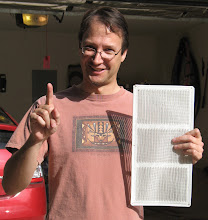It turned out that a pretty good linear model for the response of energy usage to varying cooling degree days (CDD's) took into account the temperature of the previous month as well as the temperature of the current month. The fascinating part of this was that, when determining how much energy my house was going to use, the temperature of the previous month mattered 2.6 times more than the current outside temperature.
This flies in the face of everything that I had learned about homes and insulation theory, at least before I started down the path of Energy Efficiency enlightenment. How is that? Well, like many of you out there, I had learned that the way to keep your buildings cool was to keep that hot air out, and keep a good thermal wall between the cool inside air and the hot outside air, in the form of things like double-pane windows, thick walls, and thick insulation. This would slow the flow of heat from the hot outside air into the interior airspace. And to be sure, my house is now well sealed and has decent windows. However, if that were the 100% correct approach, then why does my real world data show that some factor other than the current outside air temperature matters more? In other words, if the problem is really hot outside air, why doesn't the current outside air temperature dominate the model? If the traditional insulation theory is valid in my case, why does the temperature of air from last month that's not even around any more account for some 72% of the correlation, while the supposed main problem, hot air currently surrounding the house, accounts for only 28%?
Something is definitely amiss with our theory.
Ruminating on this problem leads us to an inescapable conclusion: in my area, during my cooling season, the main heat transfer mechanism into my house must not be direct convection from hot outside air. The traditional "double-pane window, lots of insulation" approach which attacks the convection problem is quite literally missing 72% of the target.
So how is most of the heat entering my house? Well, we have exactly one clue to help us find the culprit. Since we've seen that greatest determinant of the energy usage in June, for example, is the temperature in May, it must have to do with the heat being stored over time in someplace other than the outside air. Possible culprits:
- Heat stored in the ground -- During the course of the typical dry summer here in central Texas, the ground becomes parched and unable to cool itself through the mechanism of evaporation, since there is no water to evaporate. Much of the vegetation also goes dormant to survive, not performing its usual transpiration which might also effect some cooling. The ground is in thermal contact with my house's foundation, and heat could certainly conduct into the concrete foundation, and once there, into the interior airspace via conduction or radiation.
- Heat stored in all the thermal masses around my house -- Neighboring houses (all of which have nice heat-storing brick sides), sidewalks, and streets all store heat during the day, and radiate so much of it that it is noticeable even to the casual observer walking by after sunset. That radiated energy will be coming into my house from low angles and thus will unfortunately avoid my under-the-rafters radiant barrier.
- Heat stored in the thermal mass of my own house -- The bricks on the outside walls certainly store a lot of heat, and that heat can conduct or radiate into the interior of the house. The attic itself consists of a lot of wood and some metal as well as insulation, all of which can and do heat up and store that heat over time, again conducting or radiating to become a problem.
To address #2 and #3, having a radiant barrier in all the walls and windows would go a long ways towards reducing the heat gain there. Even my own bricks could be separated via a radiant barrier from the interior space, keeping their significant heat gain from being a problem on the inside of the house. I would be interested to learn how much heat gain is radiating in through my windows, and how much through the walls. There are "low-e" (emissivity) coatings that can be added to existing windows, and I suspect those could be a significant help to me.
Unfortunately for #3 (the heat stored in the thermal mass of my own house) since my house is already built, it would be prohibitively difficult and expensive to rip open the walls and install foil barrier there.
So with this analysis we have identified 3 possible culprits for the main predictor of the heat load coming into the house, and only one of them can be partially addressed as a retrofit project: the radiation of heat in through my windows from nearby sources. The others needed to be addressed in construction, and it is now too late for that.
Well, now that the attic is pretty well taken care of, our analysis of that mysterious 2.6 factor seems to be pointing us in the direction of windows. And so let us begin to follow this new trail; let us examine and look into the efficiency of windows, and how to improve it, soon...


No comments:
Post a Comment